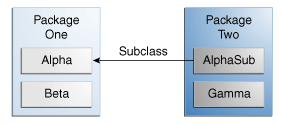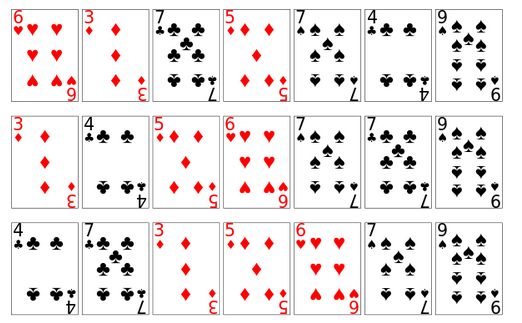First Word
Permutation questions provide you with a list of items, and you build, validate and return a combination of these items. The standard solution is to sort the input first, and add items 1 by 1.
Do not try to solve the problems with anything other than the template given below, because otherwise the code is impossible to be bug-free.
Though the code is standard, many question are very difficult, and most of time duplication removal can be tough.
Template
public List<List<Integer>> subsets(int[] num) {
List<List<Integer>> result = new ArrayList<List<Integer>>();
if(num == null || num.length == 0) {
return result;
}
Arrays.sort(num);
subsetsHelper(result, new ArrayList<Integer>(), num, 0);
return result;
}
private void subsetsHelper(List<List<Integer>> result,
List<Integer> list, int[] num, int pos) {
result.add(new ArrayList<Integer>(list));
for (int i = pos; i < num.length; i++) {
list.add(num[i]);
subsetsHelper(result, list, num, i + 1);
list.remove(list.size() - 1);
}
}
Note: 2nd last line “subsetsHelper(result, list, num, i + 1);”.
It’s easy to mistake it as “pos+1” instead of “i+1”, which will result in TLE.
Question list
Subsets
Permutations
Subsets II
Permutations II
Additional
Combination Sum
Combination Sum II
Palindrome Partitioning
Palindrome Partitioning II
Restore IP Addresses
Combinations
Letter Combinations of a Phone Number
Code
Subsets - good example for practise (by applying the model)
public List<List<Integer>> subsets(int[] num) {
List<List<Integer>> result = new ArrayList<List<Integer>>();
if(num == null || num.length == 0) {
return result;
}
Arrays.sort(num);
helper(result, new LinkedList<Integer>(), num, 0);
return result;
}
private void helper(List<List<Integer>> ans, List<Integer> path, int[] num, int position) {
ans.add(new LinkedList<Integer>(path));
for (int i = position; i < num.length; i ++) {
path.add(num[i]);
helper(ans, path, num, i + 1);
path.remove(path.size() - 1);
}
}
Permutations
public List<List<Integer>> permute(int[] num) {
List<List<Integer>> ans = new LinkedList<List<Integer>>();
if (num == null || num.length == 0) {
return ans;
}
helper(ans, new LinkedList<Integer>(), num);
return ans;
}
private void helper(List<List<Integer>> ans, List<Integer> path, int[] num){
if (path.size() == num.length) {
ans.add(new LinkedList<Integer>(path));
return;
}
for (int i = 0; i < num.length; i ++) {
if (!path.contains(num[i])) {
path.add(num[i]);
helper(ans, path, num);
path.remove(path.size() - 1);
}
}
}
Subsets II - good example for practise
We only care how many times we use the duplicate number, we care not the order. So, only 3 lines of code is added based on previous solution.
public List<List<Integer>> subsetsWithDup(int[] num) {
List<List<Integer>> result = new ArrayList<List<Integer>>();
if(num == null || num.length == 0) {
return result;
}
Arrays.sort(num);
helper(result, new LinkedList<Integer>(), num, 0);
return result;
}
private void helper(List<List<Integer>> ans, List<Integer> path, int[] num, int position) {
ans.add(new LinkedList<Integer>(path));
for (int i = position; i < num.length; i ++) {
if (i > position && num[i - 1] == num[i]) {
// if duplicate, only append num[position]
continue;
}
path.add(num[i]);
helper(ans, path, num, i + 1);
path.remove(path.size() - 1);
}
}
Permutations II
public List<List<Integer>> permuteUnique(int[] num) {
List<List<Integer>> ans = new LinkedList<List<Integer>>();
if (num == null || num.length == 0) {
return ans;
}
Arrays.sort(num);
helper(ans, new LinkedList<Integer>(), new int[num.length], num);
return ans;
}
private void helper(List<List<Integer>> ans, List<Integer> path, int[] visited, int[] num){
if (path.size() == num.length) {
ans.add(new LinkedList<Integer>(path));
return;
}
for (int i = 0; i < num.length; i ++) {
if (visited[i] == 1) {
continue;
}
if (i > 0 && visited[i-1] == 0 && num[i - 1] == num[i]) {
continue;
}
visited[i] = 1;
path.add(num[i]);
helper(ans, path, visited, num);
visited[i] = 0;
path.remove(path.size() - 1);
}
}
Combination Sum
public ArrayList<ArrayList<Integer>> combinationSum(int[] candidates, int target) {
ArrayList<ArrayList<Integer>> ans = new ArrayList<ArrayList<Integer>>();
Arrays.sort(candidates);
helper(ans, new ArrayList<Integer>(), candidates, 0, target);
return ans;
}
private void helper(ArrayList<ArrayList<Integer>> ans, ArrayList<Integer> path,
int[] nums, int pos, int target) {
if (target < 0) {
return;
} else if (target == 0) {
ans.add(new ArrayList<Integer>(path));
return;
}
for (int i = pos; i < nums.length; i ++) {
path.add(nums[i]);
helper(ans, path, nums, i, target - nums[i]);
path.remove(path.size() - 1);
}
}
Combination Sum II
public ArrayList<ArrayList<Integer>> combinationSum2(int[] candidates, int target) {
ArrayList<ArrayList<Integer>> ans = new ArrayList<ArrayList<Integer>>();
Arrays.sort(candidates);
helper(ans, new ArrayList<Integer>(), candidates, 0, target);
return ans;
}
private void helper(ArrayList<ArrayList<Integer>> ans, ArrayList<Integer> path,
int[] nums, int pos, int target) {
if (target < 0) {
return;
} else if (target == 0) {
ans.add(new ArrayList<Integer>(path));
return;
}
for (int i = pos; i < nums.length; i ++) {
if (i > pos && nums[i-1] == nums[i]) {
continue;
}
path.add(nums[i]);
helper(ans, path, nums, i + 1, target - nums[i]);
path.remove(path.size() - 1);
}
}
Palindrome Partitioning
Naive approach can AC:
public ArrayList<ArrayList<String>> partition(String s) {
ArrayList<ArrayList<String>> ans = new ArrayList<ArrayList<String>>();
if (s == null || s.length() == 0) {
return ans;
}
helper(ans, new ArrayList<String>(), s, 0);
return ans;
}
private void helper(ArrayList<ArrayList<String>> ans, ArrayList<String> path, String s, int pos) {
if (pos == s.length()) {
ans.add(new ArrayList<String>(path));
return;
}
for (int i = pos + 1; i <= s.length(); i++) {
String sub = s.substring(pos, i);
if (!isPlm(sub)) {
continue;
}
path.add(sub);
helper(ans, path, s, i);
path.remove(path.size() - 1);
}
}
private boolean isPlm(String str) {
int left = 0, right = str.length() - 1;
while (left < right) {
if (str.charAt(left) != str.charAt(right))
return false;
left++;
right--;
}
return true;
}
Use DP to optimize the process of palindrome validation.
// palindrome validation optimized with DP
public ArrayList<ArrayList<String>> partition(String s) {
ArrayList<ArrayList<String>> ans = new ArrayList<ArrayList<String>>();
if (s == null || s.length() == 0) {
return ans;
}
helper(ans, new ArrayList<String>(), s, 0, palindromeMap(s));
return ans;
}
private void helper(ArrayList<ArrayList<String>> ans,
ArrayList<String> path, String s, int pos, boolean[][] palinMap) {
if (pos == s.length()) {
ans.add(new ArrayList<String>(path));
return;
}
for (int i = pos; i < s.length(); i++) {
if (!palinMap[i][pos]) {
continue;
}
path.add(s.substring(pos, i + 1));
helper(ans, path, s, i + 1, palinMap);
path.remove(path.size() - 1);
}
}
private boolean[][] palindromeMap(String s) {
int len = s.length();
boolean[][] map = new boolean[len][len];
char[] ss = s.toCharArray();
for (int i = 0; i < len; i++) {
for (int j = i; j >= 0; j--) {
if (i == j) {
map[i][j] = true;
} else if (i - j == 1) {
map[i][j] = ss[i] == ss[j];
} else {
map[i][j] = (ss[i] == ss[j]) & map[i - 1][j + 1];
}
}
}
return map;
}
Palindrome Partitioning II
Used above template and got TLE. Turns out, this is a pure DP question.
Skip for now.
Restore IP Addresses
public List<String> restoreIpAddresses(String s) {
List<String> ans = new LinkedList<String>();
if (s == null || s.length() == 0) {
return ans;
}
helper(ans, s, "", 0, 0);
return ans;
}
private void helper(List<String> ans, String s, String path, int pos, int count) {
if (count == 4) {
if (pos == s.length()) {
ans.add(path.substring(1));
}
return;
}
for (int i = pos; i < s.length(); i++) {
if (i - pos >= 3) {
break;
}
if (!isValidNum(s.substring(pos, i + 1))) {
continue;
}
String newPath = path + "." + s.substring(pos, i + 1);
helper(ans, s, newPath, i + 1, count + 1);
}
}
private boolean isValidNum(String str) {
if (str.length() > 1 && str.charAt(0) == '0') {
return false;
}
int num = Integer.parseInt(str);
if (num < 0 || 255 < num) {
return false;
}
return true;
}
Combinations
public List<List<Integer>> combine(int n, int k) {
List<List<Integer>> ans = new LinkedList<List<Integer>>();
if (n == 0 || k == 0 || n < k) {
return ans;
}
helper(ans, new LinkedList<Integer>(), n, k, 1);
return ans;
}
private void helper(List<List<Integer>> ans, List<Integer> path, int n, int k, int pos) {
if (path.size() == k) {
ans.add(new LinkedList<Integer>(path));
return;
}
for (int i = pos; i <= n; i++) {
path.add(i);
helper(ans, path, n, k, i + 1);
path.remove(path.size() - 1);
}
}
Letter Combinations of a Phone Number
public List<String> letterCombinations(String digits) {
List<String> ans = new LinkedList<String>();
if (digits == null) {
return ans;
}
String[] pad = new String[]{
" ","","abc","def","ghi","jkl","mno","pqrs","tuv","wxyz"};
helper(ans, "", pad, digits, 0);
return ans;
}
private void helper(List<String> ans, String path, String[] pad, String digits, int pos) {
if (path.length() == digits.length()) {
ans.add(path);
return;
}
String letters = pad[digits.charAt(pos) - '0'];
for (int i = 0; i < letters.length(); i++) {
path += letters.charAt(i) + "";
helper(ans, path, pad, digits, pos + 1);
path = path.substring(0, path.length() - 1);
}
}
Conclusion
Remember the model! It applies to most search question.





